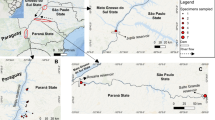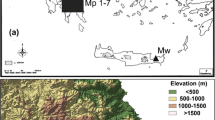Abstract
Deschampsia littoralis is an endemic tetraploid Poaceae occurring on the shores of pre-Alpine lakes. It is closely related to the diploid and widespread D. cespitosa. Several D. littoralis populations from Lake Constance are vegetatively propagating through pseudoviviparous spikelets. These latter populations were formerly described as a separate species, D. rhenana. Still, the species status of D. rhenana has been questioned since, apart from pseudovivipary, no morphological differentiation from D. littoralis is observed. Both species are highly endangered and accurate assessment of taxon status is needed for conservation management. We used amplified fragment length polymorphism fingerprinting to assess whether D. rhenana from Lake Constance (43 specimens) was genetically differentiated from D. littoralis (11 specimens collected at Lac de Joux, incl. Lac Brenet) and the widespread D. cespitosa (48 specimens). An analysis of molecular variance (AMOVA) showed that 12 % of the genetic diversity occurred among the three species, 7 % occurred among populations within species and 81 % within populations. Principal coordinate analysis and fuzzy c-means clustering showed that D. rhenana was genetically distinct from D. littoralis. In addition, both species differed in levels of genetic diversity and clustering, with D. rhenana being the most divergent and structured species. D. littoralis appeared as genetically intermediate between D. rhenana and D. cespitosa. These results suggested that (1) all species are closely related, (2) genetic variation within populations is high even in the asexually propagating D. rhenana and (3) D. rhenana is more distinct from D. cespitosa than is D. littoralis. We therefore suggest to treat D. rhenana from Lake Constance and D. littoralis from Lac de Joux as independent evolutionary units in conservation management.



Similar content being viewed by others
References
Albers F (1975) Pollenmorphologie und Chromosomenzahlen des Poaceen-Subtribus Deschampsiinae Holub. Grana 15:7–17
Albers F (1978) Beitrag zur Taxonomie, Systematik und Evolution der Subtriben Aristaveninae und Airinae (Gramineae-Aveneae). Habilitation thesis. University of Kiel, Kiel
Arrigo N, Tuszynski JW, Ehrich D, Gerdes T, Alvarez N (2009) Evaluating the impact of scoring parameters on the structure of intra-specific genetic variation using RAWGENO, an R package for automating AFLP scoring. BMC Bioinformatics 10:33
Arrigo N, Guadagnuolo R, Lappe S, Pasche S, Parisod C, Felber F (2011) Gene flow between wheat and wild relatives: empirical evidence from Aegilops geniculata, Ae. neglecta and Ae. triuncialis. Evol Appl 4:685–695
Bell AD (1991) Plant form. An illustrated guide to flowering plant morphology. Oxford University Press, Oxford
Bush EJ, Barrett SCH (1993) Genetics of mine invasions by Deschampsia cespitosa (Poaceae). Can J Bot 71:1336–1348
Cardone S, Sawatani P, Rush P, García AM, Poggio L, Schrauf G (2009) Karyological studies in Deschampsia antarctica Desv. (Poaceae). Polar Biol 32:427–433
Chiapella J (2000) The Deschampsia cespitosa complex in central and northern Europe: a morphological analysis. Bot J Linn Soc 134:495–512
Chiapella JO, DeBoer VL, Anico GC, Kuhl JC (2011) A morphological and molecular study in the Deschampsia cespitosa complex (Poaceae; Poeae; Airinae) in Northern America. Am J Bot 98:1366–1380
Conert HJ (1998) Hegi`s Illustrierte Flora von Mitteleuropa. Angiospermae: Monocotyledones 1 (2) Poaceae (Echte Gräser oder Süßgräser). Parey, Berlin
Crawford RMM (2008) Plants at the margin. Cambridge University Press, Cambridge
Davy AJ (1980) Biological flora of the British Isles: Deschampsia cespitosa (L.) Beauv. J Ecol 68:1075–1096
Delarze R, Druart P, Kozlowski G, Moret J-L, Prunier P, Gmür Ph (2004) Arenaria gothica et autres plantes rares des rives lacustres de la Vallée de Joux (Vaud, Suisse). Quelques observations recentes et premières données autécologiques. Bull Soc Vaud Sc Nat 89:1–11
Dienst M, Strang I, Peintinger M (2004) Entdeckung und Verlust botanischer Raritäten am Bodenseeufer - das Leiner-Herbar und die Strandrasen. Ber Bot Arbeitsgem Südwestdeutschland Beih 1:209–230
Ehrich D (2006) AFLPdat: a collection of R functions for convenient handling of AFLP data. Mol Ecol Notes 6:603–604
Elmqvist T, Cox PA (1996) The evolution of vivipary in flowering plants. Oikos 77:3–9
Evanno G, Regnaut S, Goudet J (2005) Detecting the number of clusters of individuals using the software STRUCTURE: a simulation study. Mol Ecol 14:2611–2620
Excoffier L, Smouse PE, Quattro JM (1992) Analysis of molecular variance inferred from metric distance among DNA haplotypes: application to human mitochondrial DNA restriction data. Genetics 131:479–491
Fischer M, Weyand A, Rudmann-Maurer K, Stöcklin J (2011) Adaptation of Poa alpina to altitude and land use in the Swiss Alps. Alp Bot 121:91–105
Gaudin J (1828) Flora Helvetica, vol 1. Orell Füssli, Zürich
Gehring JL, Linhart YB (1992) Population structure and genetic differentiation in native and introduced populations of Deschampsia cespitosa (Poaceae) in the Colorado Alpine. Am J Bot 79:1337–1343
Gremli A (1874) Excursionsflora der Schweiz. Christen, Aarau
Gugerli F, Englisch T, Niklfeld H, Tribsch A, Mirek Z, Ronikier M, Zimmermann NE, Holderegger R, Taberlet P, INTRABIODIV Consortium (2008) Relationships among levels of biodiversity and the relevance of intraspecific diversity in conservation: a project synopsis. Persp Plant Ecol Evol Syst 10:259–281
Hedberg O (1958) Cyto-taxonomic studies in Scottish mountain plants, notably Deschampsia cespitosa (L.) PB., s.lat. Svensk Bot Tidskrift 52:37–46
Hedberg O (1986) On the manifestation of vivipary in Deschampsia caespitosa s. lat. Symb Bot Upsaliensis 27:183–192
Heide OM (1989) Environmental control of flowering and viviparous proliferation in seminiferous and viviparous arctic populations of two Poa species. Arct Alp Res 21:305–315
Hess HE, Landolt E, Hirzel R (1967) Flora der Schweiz und angrenzender Gebiete. Volume 1: Pteridophyta bis Caryophyllaceae. Birkhäuser, Basel
Holderegger R, Stehlik I, Lewis Smith RI, Abbott RJ (2003) Populations of Antarctic Hairgrass (Deschampsia antarctica) show low genetic diversity. Arct Antarct Alp Res 35:214–217
Johnson AW, Packer JG (1968) Chromosome numbers in the Flora of Ogotoruk Creek, N.W. Alaska. Bot Notiser 121:403–456
Käsermann C, Moser DM (1999) Merkblätter Artenschutz—Blütenpflanzen und Farne. BUWAL, Bern
Kawano S (1962) Cytogeography and evolution of the Deschampsia cespitosa complex. Can J Bot 41:719–742
Körner C (1999) Alpine plant life. Springer, Berlin
Lang G (1967) Die Ufervegetation des westlichen Bodensees. Archiv Hydrobiol Suppl 1:437–574
Lee JA, Harmer R (1980) Vivipary, a reproductive strategy in response to environmental stress? Oikos 35:254–265
Münzing A (1980) Mode of propagation and chromosomal peculiarities in Scotch material of Poa alpina. Hereditas 92:291–296
Nkongolo KK, Deck A, Michael P (2001) Molecular and cytological analyses of Deschampsia cespitosa populations from Northern Ontario (Canada). Genome 44:818–825
Nygren A (1949) Studies on vivipary in the genus Deschampsia. Hereditas 35:27–32
Peakall R, Smouse PE (2006) GENALEX 6: genetic analysis in EXCEL. Population genetic software for teaching and research. Mol Ecol Notes 6:288–295
Peintinger M, Prati D, Winkler E (2007) Water-level fluctuations and dynamics of amphibious plants at Lake Constance: long-term study and simulation. Persp Plant Ecol Evol Syst 8:179–196
Pierce S, Stirling CM, Baxter R (2003) Pseudoviviparous reproduction of Poa alpina var. vivipara L. (Poaceae) during long-term exposure to elevated atmospheric CO2. Ann Bot 91:613–622
Purdy BG, Bayer RJ (1995) Genetic diversity in the tetraploid sand dune endemic Deschampsia mackenzieana and its widespread progenitor D. cespitosa (Poaceae). Am J Bot 82:121–130
Rothera SL, Davy AJ (1986) Polyploidy and habitat differentiation in Deschampsia cespitosa. New Phytol 102:449–467
Rudmann-Maurer K, Weyand A, Fischer M, Stöcklin J (2007) Microsatellite diversity of the agriculturally important alpine grass Poa alpina in relation to land use and natural environment. Ann Bot 100:1249–1258
Soltis PS, Soltis DE (2009) The role of hybridization in plant speciation. Annu Rev Plant Biol 60:561–588
van de Wouw M, van Dijk P, Huiskes AHL (2008) Regional genetic diversity patterns in Antarctic hairgrass (Deschampsia antarctica Desv.). J Biogeogr 35:365–376
Ziltener R (1998) Morphologie, Populationsstruktur und Populationsgenetik von Deschampsia littoralis am Bodensee. Diploma thesis. University of Zürich, Zürich
Acknowledgments
This study was partly funded by the nature conservation authority of the Canton of Thurgau (Fachstelle Naturschutz). N. Arrigo was funded by the Swiss National Science Foundation (grant No. PBNEP3-132747). We thank Michael Dienst, Rolf Niederer, Rolf Rutishauser, Gregor Schmitz, Irene Strang and Regina Ziltener for their support. We are grateful to two anonymous reviewers and Jürg Stöcklin for constructive comments on a previous draft of the manuscript.
Author information
Authors and Affiliations
Corresponding author
Electronic supplementary material
Below is the link to the electronic supplementary material.
Rights and permissions
About this article
Cite this article
Peintinger, M., Arrigo, N., Brodbeck, S. et al. Genetic differentiation of the endemic grass species Deschampsia littoralis at pre-Alpine lakes. Alp Botany 122, 87–93 (2012). https://doi.org/10.1007/s00035-012-0107-y
Received:
Accepted:
Published:
Issue Date:
DOI: https://doi.org/10.1007/s00035-012-0107-y




